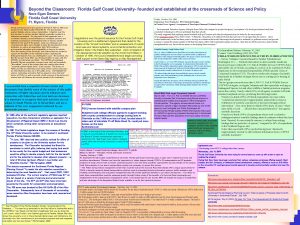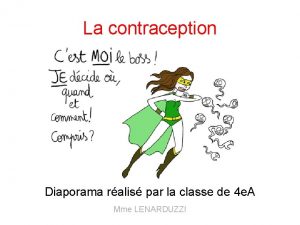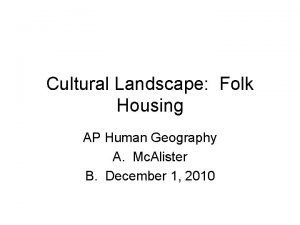UNIVERSITY OF CAPE COAST University of Cape Coast
































- Slides: 32

UNIVERSITY OF CAPE COAST University of Cape Coast, Ghana

Creative Arts, Music and Drama in Early Childhood Education Dr. Awo Sarpong asarpong@ucc. edu. gh Department of Basic Education, Faculty of Education Foundations College of Education Studies, UCC

Children’s Artistic Development Lecture by Dr. Awo Sarpong

Lesson Objectives • Identification of the Stages of Artistic Development in Children • Identification of Characteristics of Stages of Scribbling

Introduction • Human Expression is artistic by nature. Thus development of expression is synonymous with artistic development. • Just like we develop other skills like walking and running in stages, we develop artistic skills in the same way. • Understanding the stages of artistic development (stages of the development of the human capacity to express itself) can help you become a more effective creative arts teacher.

The Visual Arts as Human Expression • Expression of thoughts, ideas and feelings in visual form. • Eg. Drawing, making pictures, building things, are all activities that express an inner reality or are a response of the child to stimuli within its environment.

SIX STAGES IN ARTISTIC DEVELOPMENT 1. 2. 3. 4. 5. 6. Scribbling Stage (2 -4 years) Pre-schematic Stage (4 -7 years) The Schematic Stage (7 -9 years) The Gang Age (9 -12 years) Pseudo-Naturalistic Stage (12 -14 years) Adolescent Art (14 -17 years)

STAGES OF ARTISTIC DEVELOPMENT The Scribbling Stage • The Beginnings of Self-Expression • Age: 2 – 4 years

SCRIBBLING • The first expressive marks that children make upon the visual world. • An important step in a child’s development; beginning of expression which leads to drawing, painting and writing.

• The way these first marks are received and the attention paid to them cause children to develop attitudes about self-expression which will remain with them as they start schooling. • Unfortunately, scribbling has negative connotations of ‘waste’ of time.

DEVELOPMENT OF SCRIBBLING • Scribbles tend to follow a predictable order. • Scribbling begins as random marks on paper and evolves into drawings that have content recognizable to adults. • Images suggesting impulse to express ideas and thoughts in graphical form appear around 18 months and prevail up until about 4 years.

CATEGORIES OF SCRIBBLES Scribbles generally fall into three main categories: 1. Disordered Scribbles 2. Controlled scribbles 3. Named scribbles

DISORDERED SCRIBBLES • First Marks • Generally random • Children does not seem to recognize that he can make scribbles do what he wants. He often looks away while scribbling. • Scribbles vary in length and direction; repetitions as children swing arms back and forth.


• Line quality varies, with somewhat accidental results. • Crayon may be held upside down or sideways; it may be grasped in the fist or held in between the fists. • Fingers and wrist are not used to control drawing instrument, rather the arm and body

• Scribbles are made by larger sweeps of the body since scribblers have not yet developed fine muscle control. • Scribbles are not an attempt to represent the external visual environment; they are based on the expressiveness of the child through its psychological and physical development and not upon representational intent. • Scribbles are enjoyable for children as they swing their bodies; crayons are interesting for them. • Children all over the world scribble for the sheer enjoyment of the expressing themselves through body movement against a surface.

CONTROLLED SCRIBBLING

• Scribbling that is the result of child discovering connection between motions and marks on paper. • Occurs about six months after he has started scribbling. • Important step because child has discovered visual control over marks he is making. • Drawing quality does not really improve; what matters at this stage is the discovery of control over actions and marks.

• Enthusiasm increases as child discovers coordination between visual and motor ability. • Motions vary as child sees results of his actions and desires to see what each different motion will produce. • Lines are drawn with greater vigor. Direction of lines vary: horizontal, vertical, or circular. • At this stage drawing can be so engaging that children will have their noses almost glued to the paper.

• Children spend twice as long a time drawing • Occasionally will change or add different colour to drawing. • The page will often be filled, deliberately. • Experimentation with different ways of handling crayon, through by three, he is close to gripping like an adult. • He understands he can copy a line, but will choose not to and will instead do his own thing. • This is the time child begins to discover patterns between what he has drawn and something in his environment. • His intentions do not go beyond movement of his crayon; his enjoyment is basically kinesthetic in nature.

THE NAMING OF SCRIBBLING

• Children begin to give names to their drawings when they are a few months into their third year. • A child may say of his drawing, “I am running”, or “ This is maa”, though the drawings may not yet resemble anyone, or anything. • A significant change, as he is now connecting his motions to the world around him. • Drawings still haven't changed much, though. • He still enjoys the physical motion of scribbling and if given a new drawing he will spend more time on it than when he was younger.

• Conversations about the drawing become a means for the child to express himself not only in visual form but combine with linguistic skills. He is developing. • Children start to announce what they will be drawing, before the activity starts. • Drawings are still lines and ‘nothing’ to the adult, but for the child each wave made, each different line made means something new and different. • The great thing is that the child gives interpretation to the scribbles, an interpretation of his thoughts.

• Instead of discouraging, a teacher should invest encouragement into the child’s efforts, for if he successfully builds confidence in his ability at the scribbling stage, he will safely move up to the next stage: The Pre-schematic Stage (4 -7 years)








NEXT WEEK 1. 2. 3. Pre-schematic Stage (4 -7 years) The Schematic Stage (7 -9 years) Content of the Creative Arts (1)
 University of cape coast
University of cape coast Elim - cape south coast
Elim - cape south coast Cape breton university
Cape breton university Florida gulf coast university founded
Florida gulf coast university founded California coast university challenge exam answers
California coast university challenge exam answers Bitou cape
Bitou cape Cape henlopen soccer club
Cape henlopen soccer club Diaporama sur la contraception
Diaporama sur la contraception Ford transit cape cod
Ford transit cape cod Safecape
Safecape Tundra landforms
Tundra landforms Earth chakras map
Earth chakras map Aslp cape cod
Aslp cape cod Cape information technology unit 1 notes
Cape information technology unit 1 notes Cape horn facts
Cape horn facts Rovos rail cape town to dar es salaam
Rovos rail cape town to dar es salaam Exhibition booth johannesburg
Exhibition booth johannesburg Cape flats dune strandveld
Cape flats dune strandveld Milkor integrated systems cape town
Milkor integrated systems cape town Henlopen soccer club
Henlopen soccer club Brassica oleracea l. var. italica
Brassica oleracea l. var. italica Cape flats nature reserve
Cape flats nature reserve Jim gordon cape wind
Jim gordon cape wind Nc residency determination service
Nc residency determination service Cape funding list
Cape funding list Cape dezhnev
Cape dezhnev Osd cape
Osd cape School health.dhis.dhmis.org
School health.dhis.dhmis.org Upper cape tech nursing program
Upper cape tech nursing program Humanitarian engineers in cape york
Humanitarian engineers in cape york Ap human geography the cultural landscape
Ap human geography the cultural landscape Shampoo draping
Shampoo draping Milkor integrated systems
Milkor integrated systems




















































